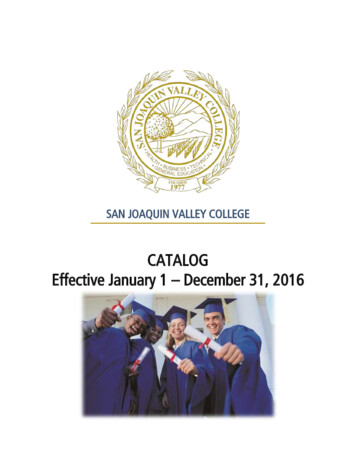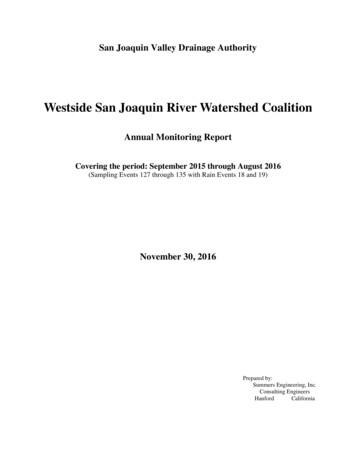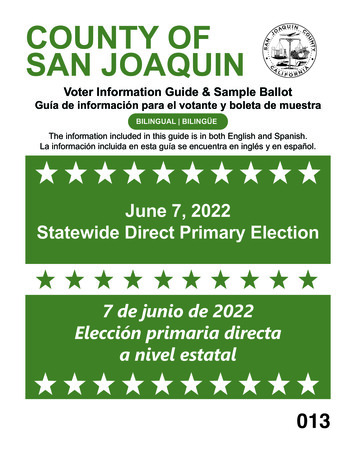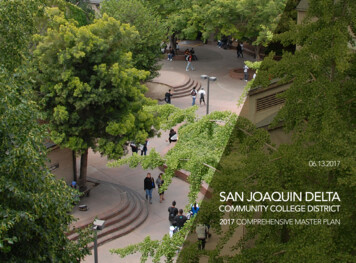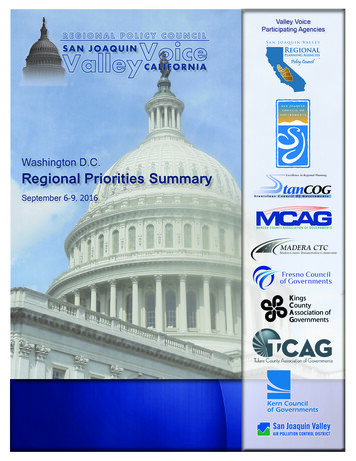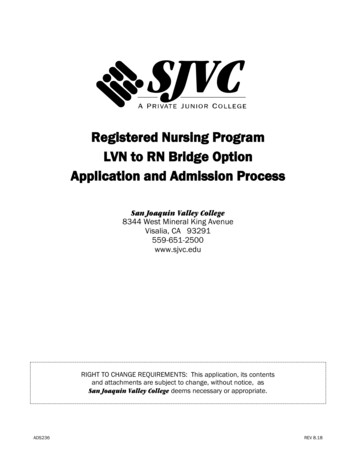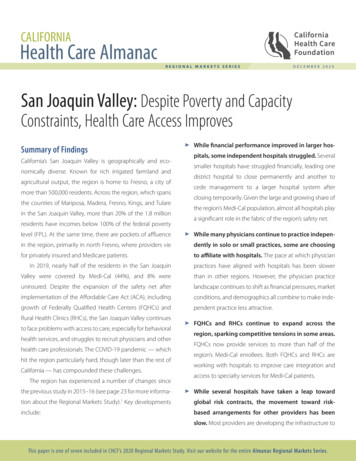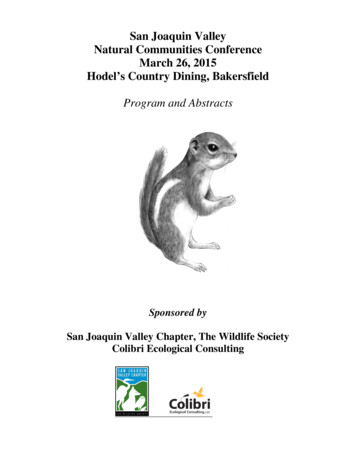
Transcription
San Joaquin ValleyNatural Communities ConferenceMarch 26, 2015Hodel’s Country Dining, BakersfieldProgram and AbstractsSponsored bySan Joaquin Valley Chapter, The Wildlife SocietyColibri Ecological Consulting
San Joaquin Valley Natural Communities ConferenceMarch 26, 2015Hodel’s Country Dining8:00 - 9:00Registration9:00 - 9:10Brian CypherLarry SaslawWelcome to the Conference, ModeratorSchedule details and announcements9:10 - 9:30David GermanoBoom and Bust or Steady As She Goes: A Comparison of the Dynamics of TwoPopulations of Kangaroo Rats in the Southern San Joaquin Desert9:30 - 9:50Craig FiehlerLong Term Population and Density Estimates for San Joaquin Kit Fox on theCarrizo Plain National Monument (2000-2014)9:50 -10:10Dan MeadeSan Joaquin kit fox presence on and near Topaz Solar Farms, San Luis ObispoCounty10:10 - 10:30Tory WestallParental Care in Urban San Joaquin Kit Foxes (Vulpes macrotis mutica):Relative Roles of Adult Group Members in Pup Rearing10:30 – 10:50BREAK10:50 - 11:10Christopher LortieFunctional assessment of animal interactions with shrub- facilitation complexes:a formal synthesis and conceptual framework11:10 – 11:30Troy RahmigWestern Kern County Conservation Gap Analysis11:30 – 1:00LUNCHRegistered participants will be served lunch.Larry SaslawErica KellyErin TennantVicky MonroeSarah TanuvasaTroy RahmigJihadda GovanSteve PruettTory WestallBobby KamanskyTaylor NobleBrian CypherQuick Talk PresentationsBlunt-nosed leopard lizard habitat use in an oilfield landscapeScat tubes and track tubes to monitor Buena Vista Lake ShrewsStatus survey for Buena Vista Lake ShrewBears in KernNRCS wildlife habitat cost-share programsUpdate of Bakersfield Habitat Conservation PlanEnvironmental Outreach at Atwell IslandKit Fox den activity at a Bakersfield Construction SiteUpdate on Sarcoptic Mange in Bakersfield Kit FoxesFunding Natural Resource ProjectsBlunt-nosed leopard lizard shrub use studyBakersfield Cactus conservationFollow up discussion on Quick Talks1:00 – 2:302:30 - 2:50Mike WestphalWhen things heated up: the drought of 2014 and the first blunt-nosed leopard lizardrangewide recruitment survey2:50 - 3:10BREAK3:10 - 3:30Pedro GarciaEffects of Urban Noise, Irrigation, and Socioeconomics On Bird Diversity andAbundance in a Semi-Arid California City3:30 - 3:50Bobby KamanskyMammal Records in Kings County along a Major Highway Corridor duringConstruction3.50 - 4:10Vicky MonroeWildlife management in Kern4:10 – 4:30Johnny GradyThe SoCalGas Quest for a Habitat Conservation Plan in the San Joaquin ValleyPosterRobyn PowersCanine Field Assistants at the Ivanpah Solar Electric Generating System: TheSafe and Successful Use of Ecological Detection Dogs in Challenging FieldConditions
AbstractsOral PresentationsBoom and Bust or Steady As She Goes: A Comparison of the Dynamicsof Two Populations of Kangaroo Rats in the Southern San JoaquinDesertDavid Germano, Department of Biology, California State University, Bakersfield, CA93311-1022, (661) 589-7846, dgermano@csub.eduSince August 1993, Larry Saslaw and I have trapped a population of Giant KangarooRats (Dipodomys ingens, GKR) at an isolated site in the southern San Joaquin Desert ofKern County. We have trapped twice a year on a 144 trap grid and in the 22 y oftrapping, we have seen two periods of high numbers of GKR ( 100 in a six-day session).The most recent peak ( 141 GKR per session) began in May 2010 and lasted until April2012, with an all-time high of 174 individual GKR caught in May 2011. However, bySeptember 2014, the numbers had dropped to two GKR. I also trap at the ButtonwillowPreserve, 20.6 km east of the GKR site. There are no GKR at this site but both TiptonKangaroo Rats (D. n. nitratoides, TKR) and Heermann’s Kangaroo Rats (D. heermannii,HKR) are caught using the same protocol as for the GKR plot. In contrast to the GKRsite, numbers of TKR and HKR have fluctuated less. I have caught as many as 62individual TKR and 47 HKR in a session (different sessions) but during the recentdrought when GKR crashed, TKR and HKR numbers have remained fairly steady with22 TKR and 11 HKR caught on the plot in September 2014. The GKR populationattained such high numbers that, coupled with a drought since 2011, kangaroo rats atevirtually all the food at their site with no residual dry matter found in September 2014.At the Buttonwillow site, the smaller TKR and HKR, whose numbers did not spike up inthe past five years, have not cleared their site of residual dry matter. Likely the seedreserve in the ground is still abundant enough to continue feeding kangaroo rats at theButtonwillow site. More long-term trapping is needed at several other sites in the SanJoaquin Desert with these three species to determine if these contrasting populationdynamics are indicative of these species.Long Term Population and Density Estimates for San Joaquin Kit Foxon the Carrizo Plain National Monument (2000-2014)Craig Fiehler, California Dept. of Fish and Wildlife, P.O. Box 9442, Bakersfield, CA93389, craig.fiehler@wildlife.ca.gov, (661) 335-2380; Co-Authors: Bob Stafford;Laura Prugh; Scott Butterfield; Brian CypherThe Carrizo Plain has long been identified as a core recovery site for the endangered SanJoaquin kit fox (Vulpes macrotis mutica). Since 2000, we have monitored kit foxpopulations in this region by conducting spotlight surveys on 109.1 km of roads on the
Carrizo Plain National Monument. We observed 2,471 kit foxes during these surveysand population estimates have ranged from a low of 65 during the fall of 2014 to a highof 1,788 during the summer of 2005 ( x 529.5). Mean kit fox density was estimated tobe 0.01 foxes/hectare (range 0.001-0.035) over this time period.The lack of precipitation over the past three years and associated reductions in smallmammal populations appear to be a major factor in the decline in kit fox numbers on theCarrizo Plain. Given current population estimates, the national monument may not belarge enough in isolation to retain a viable kit fox population during prolonged dryperiods. Adjacent lands, that typically are wetter less optimal habitat, become moresuitable during dry periods and therefore should be considered important refugia for theCarrizo kit fox population when addressing long term conservation strategies.San Joaquin kit fox presence on and near Topaz Solar Farms, San LuisObispo CountyDaniel E. Meade, Jason Dart, Christine Van Horn Job, Brian Cypher, Tory Westall, BillVanherweg, Jacqueline TilligkeitDan Meade :Dan@althouseandmeade.comSJKF use of habitat on and around Topaz Solar Farms has been studied since 2008.Surveys found an uneven distribution of use by kit fox over the approximately 10,000acre study area, with higher use in the southeastern portions where grassland was thepredominant habitat. As project construction progressed from 2011 to present, additionaltracking methods have been used to provide finer scale habitat use information. NineVHS radio collared kit foxes were located three times daily as feasible during solar farmconstruction. Currently, kit foxes regularly utilize completed solar array fields, andadditional individuals are present in the vicinity. SJKF use will continue to be tracked forfive years post-construction with scat studies (annual population study) and for threeyears with GPS telemetry on up to 20 individual kit foxes. Information gathered willprovide a measurement of SJKF use on and near this large PV solar facility.Functional assessment of animal interactions with shrub- facilitationcomplexes: a formal synthesis and conceptual frameworkChristopher J. Lortie, A. Filazzola, & D. SotomayorChristopher J. Lortie ,York University & The National Center for Ecological Analysis& Synthesis, UCSB. 1832 bath st. santa Barbara ca. 93101,chris@christopherlortie.info, 805.637.5766Facilitation studies focus primarily on plants often neglecting the extended effects thatspread through ecological networks. Plants interact with other organisms throughconsumptive effects and a myriad of non-trophic effects such as habitat amelioration orpollination. Shrubs are a dominant benefactor species in plant facilitation studies but can
also have direct and indirect effects/interactions with animals. Herein, we use asystematic review to address the following two objectives: (1) to propose a conceptualframework that explores these effects taking into consideration the functional roles of theinteracting species, and (2) to formally review the current state of this field examiningeffects beyond the widely explored plant-plant interactions. This synthesis was explicitlystructured to ensure that basal shrub-plant facilitation was included in some form with ananimal species, and consequently a relatively limited number of studies have to dateexamined the importance of these two sets of coupled interactions (77 studies in total).From this set of studies, 34 studies documented positive plant interactions generating atotal of 47 independent instances of shrub-plant-animal or shrub-animal-plantinteractions. These sets of interaction pathways were relatively evenly split betweendirect (54%) and indirect (46%) shrub interactions with animals. Hypotheses frequentlytested included seed trapping, herbivore protection, magnet pollination effects, andfacilitation-mediated secondary seed dispersal. The most common functional role ofshrubs was herbivore protection, and the most common animal role associated with plantfacilitation complexes was that of a consumer. However, animals also frequentlyprovided direct positive effects including secondary seed dispersal and pollination. Theimplications of nested complexes of shrub-plant facilitations are thus largely unexploredparticularly in their capacity to scale to other taxa or trophic levels even from therelatively simple sets of interactions summarized in this review. None of these studiesexplored bidirectional plant-animal interactions, used a network approach to describe theinteraction sets that included plant facilitation, nor contrasted interaction strengths.Nested and multi-trophically integrated sets of experiments incorporating plantfacilitation into community dynamics are thus critical in advancing management of highstress ecosystems.Parental Care in Urban San Joaquin Kit Foxes (Vulpes macrotismutica): Relative Roles of Adult Group Members in Pup RearingTory L. Westall, Brian L. Cypher, Katherine Ralls, David J. GermanoTory L. Westall, California State University, Stanislaus, Endangered Species RecoveryProgram, twestall@esrp.csustan.eduThe San Joaquin kit fox (Vulpes macrotis mutica) is Federally listed as Endangered andState listed as Threatened because of extensive habitat degradation and loss. Asubstantial population of San Joaquin kit foxes are known to reside in Bakersfield,California. Kit fox family groups typically consist of a mated pair, the young-of-theyear, and occasionally older offspring from previous years. The relative contributions ofthe parents and older offspring to the rearing of young are unknown in the urbanenvironment. Our objectives were to determine the following: the relative timeinvestment by each adult group member to pup rearing (den attendance); the tasksperformed by each adult group member in pup rearing (e.g., provisioning, guarding, etc.);and the chronology of participation and tasks performed by adult group members in puprearing. We classified group members into three categories (Mother, Father, and Helper)and monitored for three periods of the breeding season (Preparturition, Nursing, andWeaned). Our results indicated no significant difference in den attendance betweenperiods, but there was a significant difference in den attendance by role. Mothers spentsignificantly more time at the den than either Fathers or Helpers. Mothers and Fathers
had no significant difference in the number of provisioning events, but both provisionedsignificantly more than Helpers. Not surprisingly, Mothers play a critical role in puprearing and provide the most direct care to young, while Fathers search for food toprovision Mothers and pups. Helpers in the urban setting did not contribute significantlyto pup care and were only tolerated in their natal range because of a super abundance offood. Further research should investigate the role of Helpers in a natural setting todetermine the benefit they may have to pups.When things heated up: the drought of 2014 and the first blunt-nosedleopard lizard rangewide recruitment surveyMichael F. Westphal, Ecologist, Bureau of Land Management, 20 Hamilton CourtHollister, California 95023, Tel. 831-630-5023, FAX 831-630-5055mwestpha@blm.govAssessing the future impacts of global warming requires both theoretical modeling butalso the input of empirical data. Opportunities to collect relevant empirical data may beunexpected and difficult to exploit in a short time frame. Robust partnerships mayprovide a framework for rapid-response data collection when novel opportunities arise.The extreme drought of 2014 provided a unique opportunity to test models of persistencein the face of climate change in the endangered blunt-nosed leopard lizard, Gambeliasila. Due to an existing partnership between the Bureau of Land Management, CaliforniaDepartment of Fish and Wildlife, the Nature Conservancy, and UC Santa Cruz, personnelwere able to mobilize within a matter of days when preliminary data suggested thatlizards were not recruiting in some populations. By conducting rigorous surveys, fieldworkers were able to gather meaningful data from over 20 sites within the narrowwindow when neonate lizards could be observed, resulting in a dataset that confirmed astrong causal link between drought and recruitment in on Gambelia sila and alsoprovided a geographic visualization of the drought x recruitment interaction. We proposethat the relevant factors that contributed to the success of the rapid response surveywere:Pre-established partnerships, including active cross-institutional fundingmechanisms; key personnel with appropriate training; and existing lines ofcommunication.Effects of Urban Noise, Irrigation, and Socioeconomics On BirdDiversity and Abundance in a Semi-Arid California CityPedro Garcia, M. KattiPedro Garcia pgmusician@mail.fresnostate.eduEcological and socioeconomic variables must be combined to explain the composition,distribution, and population dynamics of urban wildlife. We have shown that propertyvalue and yard irrigation drive plant and bird diversity in Central California’s FresnoClovis Metro Area (FCMA). Here we focus on how four local scale factors—anthropogenic noise, property value, proximity to wetspace (flood control basins), andgreenspace (parks)—affect bird abundance and species richness. We analyzed bird counts(at 67 random points) for the years 2013 and 2014, following protocol of the Fresno Bird
Count, with concurrent noise level measurements, Zillow property value zestimates, anddistance to nearest greenspace and wetspace.Of all local scale factors, property value had a significant effect on both bird richness(R2 0.13, p 0.0002) and abundance (R2 0.17, p 0.0001) while anthropogenic noise hada significant effect (R2 0.07, p 0.038) on only bird richness in the year 2014. Whilesocioeconomics explain bird diversity across FCMA, local (within city) variation indiversity is driven by behavioral (noise) variables. We intend to continue looking atlandscape (green or wet spaces) level variables, as they have been shown in similarstudies of other cites to also be determinants in variation of bird diversity. While morefood in cities increases bird populations, species composition is more sensitive to noiseand landscape factors other than food. Urban ecology research and policy must take moremultiscale, multivariate, landscape-based, and taxon specific approaches to better managecities for biodiversity.Mammal Records in Kings County along a Major Highway Corridorduring ConstructionBobby Kamansky, Principal Biologist, Kamansky’s Ecological Consulting, BiologyProfessor, College of Sequoias, Visalia, California, bobinator1@hotmail.comLittle information exists about transportation and public infrastructure projects’construction on local biota. This study summarizes observations and findings from fourmonths of surveys along Highway 41 west of Highway 5 in Kings County, measuresemployed to avoid impacts and species observations. Highway rights of way in this partof California harbor surprising diversity and abundance of mammals, many of which arerare, protected or listed under the federal or state endangered species acts.The area is known to harbor a rich mammalian fauna. Biologists detected at least fiveclusters of San Joaquin kit fox dens (Vulpes macrotis mutica) which were monitored andcollapsed in consultation with the U.S. Fish and Wildlife Service and CaliforniaDepartment of Fish and Wildlife. Several deep dens were made into the existing road fillmaterial. Biologists also observed at least 22 American badger dens within 200 feet of theroadway in at least four clusters of dens. One den was within 10 feet of the roadway.While only San Joaquin whipsnake (a single adult, Coluber flagellum ruddocki) andcoyote were found dead on the road, coyotes are noteworthy in light of the abundance ofkit foxes because they are known to prey on them. However, new oil well was dug duringthe construction window which may have pushed at least the kit foxes in the direction ofthe construction. These records provide information about proper avoidance measuresduring construction, animal behavioral patterns and wildlife use along major highways.Western Kern County Conservation Gap AnalysisTroy Rahmig (o) 206.801.2823 (m) 408.677.8031ICF INTERNATIONAL 710 Second Avenue, Suite 550, Seattle, WA 98104,Troy.Rahmig@icfi.comNatural land cover types in western Kern County, once prevalent, have been continuallyconverted to other land uses over the last 100 years. Today conversion of natural landcovers is as prevalent as ever. However, many natural land cover are protected. The level
of protection on these lands varies, and multiple-use missions of land owners cancompromise the functionality of the natural areas for native species. As part of theBakersfield Habitat Conservation Plan (HCP)/Natural Community Conservation Plan(NCCP) an analysis was completed to categorizes the protected lands in western KernCounty into four categories, dependent on the permanence of protection and themanagement objectives for the land. It assesses the level and type of protection in placefor each natural land cover type relative to their abundance in the study area. This studyproposes goals for protection of natural communities in western Kern County based ontheir rarity and risk of future conversion to other land uses and provide recommendationsfor protection priorities. The Bakersfield HCP/NCCP will contribute to these habitatprotection goals over the next 30 years.Black Bears of KernVicky Monroe, Wildlife Biologist, Central Region, California Dept. of Fish andWildlife, Victoria.Monroe@wildlife.ca.gov’ 661-391-6087, Office: 3801 PegasusDr. // Bakersfield, CA 93308Kern County saw a dramatic spike in bear activity in 2014. More than 1,300 bear callswere made to CDFW throughout Kern County, with a total of 15 bears captured andrelocated. CDFW received 108 black bear calls and/or sightings within Bakersfield citylimits. In previous years, bear sightings in Bakersfield have only been reported once ortwice a year. Several complex factors have lead to a significant increase inreported human-wildlife conflicts. While the causes of the increase in black bear activityare myriad, the drought has had a significant impact, as the lack of water forced bears toroam further in search of food sources.The SoCalGas Quest for a Habitat Conservation Plan in the SanJoaquin ValleyJohnny Grady and Derek Rodgers, SoCalGas; s.comSoCalGas is the nation’s largest natural gas service provider, connecting 5.8 millionmeters in more than 500 communities in Southern California. Within the San JoaquinValley (SJV), SoCalGas operates and maintains 1,400 miles of transmission anddistribution pipeline over diverse terrain and vegetation communities including vernalpool, grassland, scrub, riparian, and woodland. In February 2015, SoCalGas submitted aHabitat Conservation Plan (SJV HCP) in support of an application for an incidental takepermit from the U.S. Fish and Wildlife Service, pursuant to Section 10(a)(1)(B) of theEndangered Species Act. The permit is requested for 30 years and covers 21 species ofspecial status plants and animals known from the 5.9 million-acre Plan area. Byprotecting and conserving the covered species and their habitats, the SJV HCP ensurescompliance with the Endangered Species Act as SoCalGas continues to provide longterm natural gas service to its customers.
PosterCanine Field Assistants at the Ivanpah Solar Electric GeneratingSystem: The Safe and Successful Use of Ecological Detection Dogs inChallenging Field Conditions.Robyn M. Powers, H.T. Harvey & Associates, Cal Poly Technology Park, Bldg. 83, Mt.Bishop Rd., San Luis Obispo, CA 93407, rpowers@harveyecology.com, 805-7567423; Co-authors: Katherine Ayres; Murrelet Halterman; Daniel Duke; and BrianB. BoroskiH. T. Harvey & Associates recruits, trains, and deploys ecological scent-detection dogsand handlers to survey for a variety of wildlife species. Our skillfully trained dogs,capable of discriminating a vast amount of olfactory information, can provide improvedsearch efficiency for some wildlife studies, particularly in environments where thelimitations of human vision present challenges. The Harvey Dog Program is currentlyassisting in avian fatality searches at the Ivanpah Solar Electric Generating System nearNipton, CA. The 3,500-acre site was constructed in a manner that retains nativevegetation, dominated by creosote bush and white bursage, which can potentially obstructthe view of human surveyors. The dogs have demonstrated proficiency in findingevidence of avian fatalities when specimens are small, camouflaged, or completelyhidden from view. Through careful scheduling and cooling equipment, our dogs safelysurveyed through the summer months when daily maximum temperatures averaged 102degrees Fahrenheit. Approaches that increase searcher efficiency, which improve theprecision of fatality estimates, are an important consideration when designing andconducting avian fatality studies. The application of this technique and other novelapproaches that improve the precision of estimates should be further explored to aidfatality assessments and inform management decisions based upon these studies.
NRCS wildlife habitat cost-share programs . Update of Bakersfield Habitat Conservation Plan . Environmental Outreach at Atwell Island . Kit Fox den activity at a Bakersfield Construction Site . Update on Sarcoptic Mange in Bakersfield Kit Foxes . Funding Natural Resource Projects . Blunt-nosed leopard lizard shrub use study . Bakersfield Cactus .
